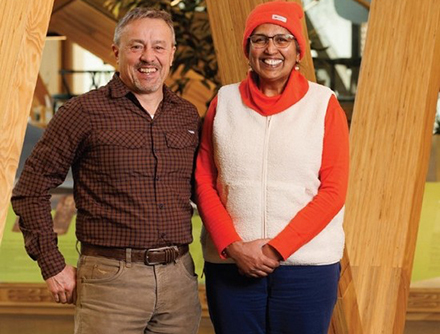
Scion’s Forests to Timber Products lead Henri Bailleres with NZTA chief engineer Sulo Shanmuganathan.
Achieving New Zealand’s net carbon zero goals by 2050 requires looking at every aspect of life – even the roads. And work that Waka Kotahi New Zealand Transport Agency is doing with support from Scion and other industry partners could help bridge the gap between now and 2050. Source: Timberbiz
For the first time in 50 years, Waka Kotahi is piloting the construction of timber bridges, representing an exciting step in its transition to a low-carbon transport system.
Waka Kotahi chief engineer Sulo Shanmuganathan says the organisation’s vision is for a low carbon, safe and healthy land transport system and Scion’s knowledge about the durability and longevity of Glulam has been key to informing the timber bridge pilot and helping achieve its wider vision.
“Through the government’s Carbon Neutral Government Programme, we are focused on playing our part to accelerate emissions reductions in the public sector by lowering our embodied carbon materials and using more sustainable construction options than what we conventionally used,” she said.
“The mahi we’re doing with Scion is very important because the far-reaching positive impacts of using more sustainable materials will benefit both the community here and now and will carry forward for future generations.
“We want the right people involved and of course Scion is very important for the development of timber bridges because they already have the depth of expertise and research developed over more than 70 years.”
Scion’s Tripti Singh and Dave Page advised Waka Kotahi on the durability of preservative-treated Glulam in New Zealand. Preservative-treated, radiata pine, glue laminated bridge beams have been in service for 60 years in New Zealand and show few problems with durability associated with decay.
Shanmuganathan says these findings gave Waka Kotahi confidence in Glulam and the ability to press ahead with its wooden bridge pilot.
Any bridge would likely take a hybrid approach combining other materials for fixing.
“Long term we want to see Glulam readily available and designers capable of using the product and timber like they use other conventional materials. Raising awareness in the sector for designers and construction is crucial for us as we transition to a low carbon, climate resilient transport system that will create a better tomorrow for us all,” Ms Shanmuganathan said.
Timber is also lightweight and more sustainable as it can be sourced locally.
A timber bridges focus group has been formed with Scion, the Scion-managed Timber Unlimited brand, Timber Design Society, and government ministries. The group meets quarterly and earlier in the year members visited Norway to learn more about timber bridges at the World Conference on Timber Engineering.
Waka Kotahi was also invited to a meeting of government agencies about barriers, opportunities, activities and possibilities for collaboration regarding using timber in the built environment.
Singh, who leads timber durability research at Scion part-time, says interacting with industry professionals in the timber focus group with Waka Kotahi has been “incredibly rewarding and enriching”.
“It has allowed the exchange of valuable knowledge and insights.”
Ms Shanmuganathan says there has already been plenty of interest in timber bridges with designs for Onetai Bridge between Paeroa and Kōpū due to go out for tender for construction. It will be the first bridge built using timber in New Zealand in 50 years.
Councils are also interested. Waitaki District Council has a 120-year-old timber bridge due for renewal and would prefer replacing it using materials, such as timber, that have a resilient history and may perform for another 120 years.
Council major transport projects project manager Mike Harrison says the council included the bridge renewal in its 2024-2027 National Land Transport Plan funding application and is engaging a design consultant to explore options that deliver a whole of life best value and cost-effective structure.
“While the build funding is not locked in yet, council and Waka Kotahi are investing in the design and consenting phase to become a deliverable project, as shovel ready as possible,” Mr Harrison said.
“This project is of a scale where all the industry partners can gain experience and knowledge for the future. Learning from the past where materials and workmanship has stood the test of time will inform future decision making.”
Scion Forest to Timber Products general manager Henri Bailleres says timber bridges have the potential to be “one of the most impactful showrooms for timber in the country.
“The engineering requirement is extreme. Materials have to survive for 100 years; they have to bear dynamic load and they are exposed to many hazards. If we can make timber bridges, we build proof of the high value of timber as a construction material.”
Scion principal researcher Doug Gaunt says timber bridges provide an opportunity for creative and statement architecture.
“Everything we do to trap a bit of carbon from the atmosphere into permanent structures is a good thing.”
Timber Unlimited technical manager Bjorn Stankowitz was in the group that travelled to Norway.
He says the group toured bridges in Europe looking at structures and durability and spoke with overseas practitioners to inform Waka Kotahi. If proper maintenance plans and protective detailing are used, wooden bridges are extremely durable.
They also pulled together a “bridge CV” containing statistics and specifications of multiple bridges for comparison purposes.
“That gives a good idea of the difference in approach to certain structural systems and ways to approach durability.”





